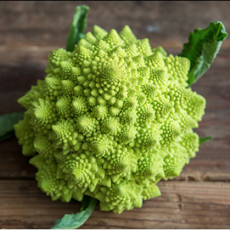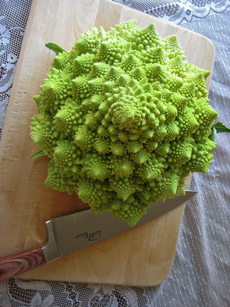TIP OF THE DAY: Romanesco, Neither Broccoli Nor Cauliflower
|
Isn’t it beautiful? Romanesco looks like it’s been sculpted by an artist. It’s a member of the cruciferous vegetables family (Brassicaceae) that includes broccoli and cauliflower, among others. If it seems exotic, that’s because we rarely find it in U.S. markets. But romanesco grown in California is in season now. In the U.S., it’s also called broccoflower, Roman broccoli, romanesco broccoli, romanesque cabbage and romanesque cauliflower. So is it broccoli or cauliflower? Actually, it’s neither. Remember high school botany taxonomy: kingdom, order, family, genus, species and sometimes, subspecies? Botanists believe that Italian farmers in the 16th century developed romanesco through cross-breeding. It was initially called broccolo romanesco. As with cauliflower or broccoli, the pointy “florets” (often called fractals after fractal art) that comprise the head are of varying sizes. They are actually individual buds of the plant’s flower. Romanesco tastes more like cauliflower, with a nutty, earthy flavor nuance and a crunchier texture. It is about the same size of a regular head of cauliflower. There is also a smaller variety, which is about half the size. The pale green shade keeps its color through cooking. |
 [1] If you can’t find it locally, order romanesco online as a special treat (photo © Good Eggs).
|
|
|
Look in your farmers markets or specialty produce stores; the crops from California are in. You can treat yourself or send a gift from Melissas.com. |
||
 [3] It’s almost to pretty to cut! Enjoy it as a centerpiece for a day or two. Photo courtesy SimplyMcGhie.Blogspot.com. |
HOW TO SERVE ROMANESCO
Romanesco can be served raw, lightly cooked, or cooked through, and can be substituted in any recipe calling for cauliflower or broccoli. It’s a shame to destroy the architecture by dicing or puréeing. We wouldn’t want to turn it into soup, for example, when we could use regular cauliflower. Instead, consider: |
|
|
RECIPE #1: ROMANESCO SALAD This recipe is from Mariquita Farm of Watsonville, California (alas, now closed), which grew romanesco for many years. 1. LIGHTLY STEAM the florets to desired consistency. While you can use them raw, a blanching or light steaming makes the texture more uniform with the other ingredients. 2. TOSS with the other ingredients and the vinaigrette, taking care not to damage the pointy “fractals.” Serve chilled or at room temperature. Ingredients 1. WHISK together the lemon juice, zest, mustard, sugar and salt in a small bowl. Add the olive oil in a slow stream, whisking constantly until the dressing is well blended. 2. TASTE and season with additional salt and pepper as desired. Drizzle over the salad and toss to coat thoroughly. The Brassicaceae family of vegetables contains powerful antioxidants that prevent the build-up of free radicals, atoms with unpaired electrons in the body that are destructive, engendering disease. Along with their nutritional elements, cruciferous vegetables aid with alkalinization (making the body less acidic), bone health, cancer prevention, cholesterol reduction and detoxification (neutralization and elimination of unwanted contaminants). The high fiber content aids in digestion, heart health, lowering blood sugar, reducing allergy reactions and inflammation, and more. |
||
